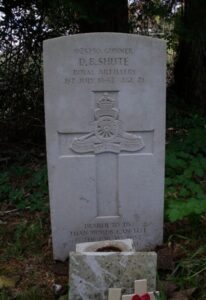Maenclochog is a small village in north Pembrokeshire, close by the villages of Rosebush and Clynderwen, about ten miles north-west of Narberth. The War Memorial for the area is situated outside St. Mary’s Church, and takes the form of a stone obelisk, with a bronze panel inlaid, which has no names inscribed. The details below are therefore just of men known to have come from Maenclochog and Llanycefn, and some are probably missing from this list. The panel bears an inscription in Welsh and English, which carries the words; ‘Safwn yma I gofio am y rhai o’r gymdogaeth hon a gollodd eu bywyd mewn rhyfeloedd er mwyn I ninnau fyw mewn rhydidd. Yn angof ni chant fod.’ In English; ‘Stand here and remember those from this locality who lost their lives in war so that we may live in freedom’.
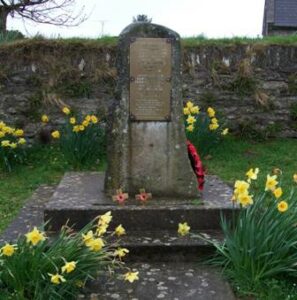
The Great War, 1914-1918
Evan Rhys Lewis Bishop, Private, 436864, Canadian Infantry. Evan was born at Llangolman on 14 February 1887, the son of Robert John and Alice Ellen Bishop. The family later moved to 10, Emma Street, Swansea. Evan then served with the Glamorgan Territorials for three years, prior to emigrating to Canada, where he worked as a miner. He enlisted at Edmonton into the Canadian Expeditionary Force on 12 February 1915, and embarked for England to join the 1st Battalion (Western Ontario), Canadian Infantry, which was attached to the 1st Brigade, 1st Canadian Division. Evan probably joined the battalion at Givenchy during the summer of 1915. The Canadians then moved to positions south of Ypres, where they fought at Mount Sorrel in June 1916. Evan must have been wounded here, possibly on 25 May 1916 by shelling, and evacuated to the Base Hospital at Boulogne, where he died on 26 June 1916. He is buried at Boulogne Eastern Cemetery, France.
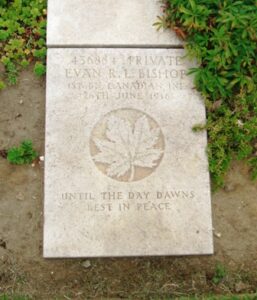
Daniel Davies, Private, 53998, Welsh Regiment. Daniel was the son of Edward and Margaret Davies, of 18, Rosebush Terrace, Maenclochog. He enlisted at Bargoed into the 14th Battalion, Welsh Regiment, which was raised in Swansea, becoming known as the Swansea Pals. The battalion then moved to Rhyl for training, where it became part of 114 Brigade, 38th (Welsh) Division. The Division had been on the Western Front since December 1915, and had seen action in Flanders before moving to the Somme in June 1916, where it fought at Mametz Wood. It then returned to Flanders, and took part in the Battle of Pilckem Ridge in July 1917, and in the following Battle of Langemarck. Daniel was killed here on 5 August 1917. He was 30 years old, and is commemorated on the Ypres (Menin Gate) Memorial.
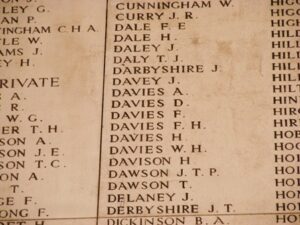
Garibaldi William Davies, Private, 61766, Royal Army Medical Corps. Garibaldi was born at Maenclochog on 5 May 1886, the son of William and Martha Davies. The family later resided at Bryn Hywel, Efailwen. He was employed by the Ocean Quarries at Blaengarw prior to the war, and married Margaret Elizabeth Pearce at Bridgend on 28 March 1910, the couple moving to 29, King Edward Street, Blaengarw, Glamorgan. Garibaldi enlisted on 26 July 1915 at Cardiff into the Royal Army Medical Corps, being posted to the 2nd/1st East Anglian Field Ambulance. This F.A. served in Gallipoli and Palestine, and was helping to rescue men wounded on the battlefield during the Battle of Gaza, when Garibaldi was Killed in Action, aged 31, on 20 July 1917. He is buried in Gaza War Cemetery, Israel.
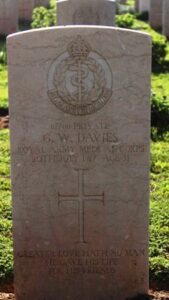
Samuel Davies, Private, 5346, Pembroke Yeomanry. Samuel was the son of Jonathan and Mary Davies, of Penrallt, Henry’s Moat, and the brother of William Davies, of Farthings Hook Mill, Henry’s Moat. He served with the 3/1st Battalion, Pembroke Yeomanry, which was a Home Service unit. Samuel died at Carmarthen Hospital on 25 March 1916, aged 30. He is buried in Henry’s Moat (Shiloh) Congregational Chapelyard.
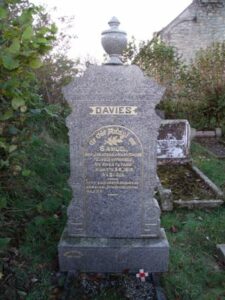
David John Evans, Private, 240474, Welsh Regiment. David was born at Rosebush, the son of John and Ann Evans. The family later moved to Brynheulog, Aberaman, Aberdare, and David enlisted there into the 1/5th Battalion, Welsh Regiment, which was the local Territorial Battalion, attached to 159 Brigade, 53rd (Welsh) Division. The Division landed at Cape Helles, Gallipoli, on 9 August 1915, and was immediately thrown into action, spending the next few days in isolated pockets, fighting against a Turkish counter-attack during the Battle of Sari Bair, and then at the Attack on Scimitar Hill. The Division remained here throughout the coming months, and suffered severe losses in manpower strength during the great November 1915 blizzard on Gallipoli, when its total strength was reduced to less than that of a full-strength Brigade. On 11 December 1915 the Division was evacuated to Mudros, and by 23 December 1915 were moved to Egypt. They remained on the Suez Canal Defences for the next twelve months, where it took part in operations against the Sultan of Darfur, and in March 1917 took part in the advance into Palestine. David was killed in action there during the Third Battle of Gaza, on 3 November 1917. He was 25 years old, and is buried in Beersheba War Cemetery, Israel.
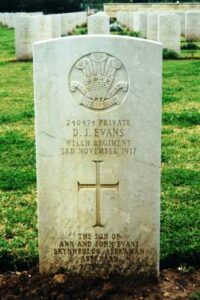
John Ewart Evans, Second Lieutenant, Devonshire Regiment. John was born at Swansea on 4 February 1899, the son of William and Anne Evans. The family later resided at Ashdown, Merthyr Mawr Road, Bridgend. Anne was the daughter of John Lawrence, of Bigney, Llanycefn, and the young John spent many a holiday with his Grandfather at Llanycefn. John worked as a Clerk at Port Talbot, prior to joining the Artist’s Rifles in April 1917. He was commissioned into the Devonshire Regiment in February 1918, and was drafted to France, where he joined the 1/5th Battalion, Devonshire Regiment, which was attached to 185 Brigade, 62nd (2nd West Riding) Division. On 5 January 1918, the Division had taken over the front line between Gavrelle and Oppy. The Germans launched their spring offensive there on 21 March 1918, and the Division took part in heavy fighting over the coming days. The Division was relieved on 31 March 1918, and was sent to the Aisne to rebuild. The Division was again caught up in heavy fighting, at the Battle of the Tardenois, where the Division took part in the fighting for the Ardre Valley. The Division then moved back to the old Somme area, and took part in the 100 days offensive. John was killed in action on 27 September 1918, when the Division captured Marcoing and Masnieres, important crossings of the Saint-Quentin Canal. He was 19 years old, and is buried at Lebucquiere Communal Cemetery Extension, France.
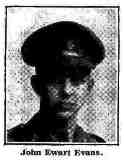
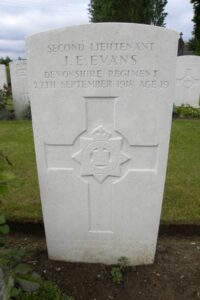
William Henry Griffiths, Sapper, 157731, Royal Engineers. William was born at Maenclochog on 15 June 1879, and prior to the war resided at Treharris with his wife Elen and daughter Harriet Mary Griffiths. William worked there as a coalminer. He enlisted at Merthyr into the Royal Engineers, and joined their 172nd Tunnelling Company. On formation, the company moved to Houplines in Northern France, and moved to the Somme in July 1915, taking over French mine workings between La Boisselle and Carnoy, before concentrating on the Mametz sector. By October 1916, the company moved north of the Ancre, facing Beaumont-Hamel, before moving to St. Eloi. William was killed in action soon after the move to St. Eloi, on 3 February 1917. He is buried at Ecoivres Military Cemetery, Mont-St-Eloi, France.
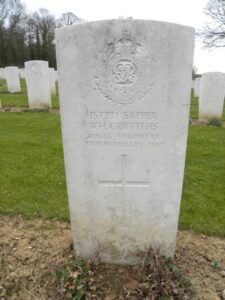
John Llewellyn Henton, Company Quartermaster Sergeant, 113, Welsh Guards. John was the son of ex P.C. John Henton and Ann Henton, of Rosebush, Maenclochog. He enlisted at Fishguard into the Grenadier Guards on 22 February 1911, and served with the regiment until transferring to the newly formed Welsh Guards in February 1915. John would have then served with the Welsh Guards as part of 3rd Guards Brigade, Guards Division, at the Battle of Loos and during the Somme Offensive in 1916, but returned home wounded on 29 October 1916. He was discharged from the army as unfit on 17 December 1916 and died at St Bartholomew’s Hospital, London on 6 March 1917, aged 25. He is buried at Wandsworth (Earlsfield) Cemetery, England.
Reverend Thomas Howell, Chaplain, Army Chaplain’s Department. Thomas was born in Newport, the son of Howell and Mary Ann Howell. The family was from Maenclochog, but with Howell being a Minister, moved around West Wales over the years. Thomas was educated at Swansea Grammar School, the University College of Wales at Cardiff, and at Brecon Congregational College. He obtained his BA at Cardiff University in 1907 and took up a position in the ministry at Leominster in 1910 where he stayed for three years. In March 1914 Thomas took up a position at The Bridge Street Congregational Church, Walsall. During 1916 he served three months in France with the YMCA, and realising that he was needed at the front, Thomas joined the Army Chaplains’ Department in June 1917, and was attached to the 6th Battalion, King’s Shropshire Light Infantry. The battalion was attached to the 20th Light Division, and had fought on the Somme in 1916, and at Passchendaele in 1917, before being moved to positions near Arras, where they took part in the Battle of Cambrai. The Division had suffered terribly at Welsh Ridge, and the on 1 December 1917 were tasked with the capture of the fortified village of Gonnelieu, on the Hindenburg Line. The attack was repulsed by the Germans, and Thomas was Killed in Action here that day, on 1 December 1917, aged 33. He is buried in Fifteen Ravine Cemetery, Villers-Plouich, France.
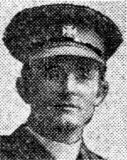
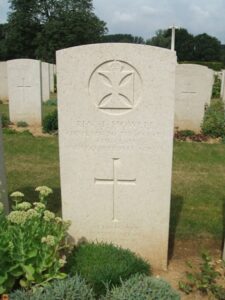
William George Howells, Private, 92196, Nott’s & Derby Regiment (Sherwood Foresters). William was the son of William and Margaret Howells, of Penuchardre, Maenclochog, and had enlisted at Maenclochog into the Army Service Corps, with the service number T/4/185988. He later transferred into the 9th Battalion, Sherwood Foresters, which was back on the Western Front, after fighting on Gallipoli, attached to 33 Brigade, 11th (Northern) Division. The Division then fought at the Battle of Flers-Courcelette during the Somme Offensive, and spent the winter on the Ancre. In June, 1917 the Division took part in the Battle of Messines, and then fought at the Battle of Langemarck during the Third Battle of Ypres. At the end of September they fought at the Battle of the Polygon Wood, then at the Battle of Broodseinde and the Battle of Poelcapelle, before moving south for the winter. William was killed on 25 November 1917 while his battalion was in the line at Loos. He was 24 years old, and is buried at Loos British Cemetery, France.
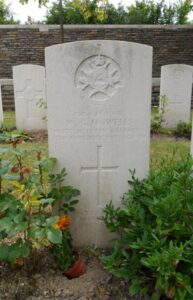
George James, Private, 55440, Royal Welsh Fusiliers. George was the son of Thomas and Phoebe James, of Gotty, Maenclochog, and had enlisted at Haverfordwest into the Pembroke Yeomanry before the outbreak of war. He later transferred into the 16th Battalion, Royal Welsh Fusiliers, which was attached to 113 Brigade, 38th (Welsh) Division. The Division had been on the Western Front since December 1915, and had seen action in Flanders before moving to the Somme in June 1916, where it fought at Mametz Wood. It then returned to Flanders, and took part in the Battle of Pilckem Ridge in July 1917, and it was here that George was killed on 30 July 1917. He was 23 years old, and is buried at Bard Cottage Cemetery, Belgium.
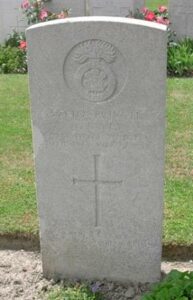
John Lewis, Sapper, 157811, Royal Engineers. John was born at Maenclochog, and had enlisted at Llanelli into the Royal Engineers. He was probably a miner before the war, as he was posted to the 254th Tunnelling Company, Royal Engineers. This company formed in England and moved to Gallipoli in December 1915. After the evacuation of Gallipoli, it moved to France and relieved 176th Company at Givenchy in spring 1916, before moving to Ypres. John was wounded while the Company were building dugouts at Ypres, and brought to a Casualty Clearing Station in the town, where he died of wounds on 22 October 1917. He is buried at Ypres Reservoir Cemetery, Belgium. He is commemorated on the Whitland War Memorial.
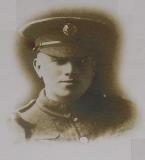
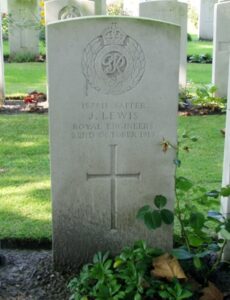
Benjamin Llewellyn, Private, 14316, Welsh Regiment. Benjamin was born in Llanycefn, to Griffith and Martha Llewelyn, of Vron, Llanycefn, Clynderwen. He enlisted at Goodwick into the 8th Battalion, the Welsh Regiment, who formed part of 40 Brigade, 13th Division and in January 1915 became Pioneers to the Division. The Division concentrated at Blackdown in Hampshire at the beginning of 1915, and by the end of June the entire Division had left the U.K. for the Mediterranean. They arrived at Mudros from Alexandria, and then were landed at Gallipoli during July, 1915, taking part in the Battles of Sari Bair, Russell’s Top and Hill 60, and were evacuated from Helles on the 6th January, 1916. They held the Suez Canal defences for a month, but were sent to Mesopotamia to attempt the Relief of the besieged Garrison at Kut during March and April 1916, and it was during this campaign that Benjamin was wounded. He died of his wounds on 28 April, 1916 and is buried at Basra War Cemetery. He was only 21 years old.
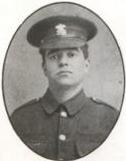
John Henry Lloyd, Lance Corporal, 28825, Somerset Light Infantry. John was the son of John and Anna Lloyd, of 74, Park St., Clydach Vale, and the husband of Lydia Lloyd, of The Bungalow, Rosebush, Maenclochog. He served with the 1st Battalion, Somerset Light Infantry, which was attached to 11 Brigade, 4th Division. The Division had been in France since the outbreak of war, and had fought in all of the major battles thereafter. In the spring of 1918 the Division was heavily hit during the German Spring offensive on the Somme, and John was badly wounded there. He was evacuated to Hospital at Etaples, but died of his wounds on 15 April 1918. John was 21 years old, and is buried at Étaples Military Cemetery, France.
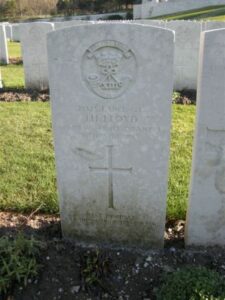
Benjamin Morris, Private, 46381, Welsh Regiment. Benjamin was the son of David and Margaret Morris, of Pantinon, Maenclochog, and had enlisted at Llandeilo into the 9th Battalion, Welsh Regiment. The battalion had moved to France in July 1915 attached to 58 Brigade, 19th (Western) Division. The Division fought during the opening attack of the Battle of Loos, and then moved to the Somme, where they took part in the second wave of the attack on Ovillers-La Boisselle on 1 July, capturing the village at heavy cost, and fought through the Somme Battles of Pozières and the Ancre in 1916. They then moved North to Ypres, taking part in the Battle of Messines, and fought on the Menin Road and at Polygon Wood, before moving up to Broodseinde, Poelcapelle and Passchendaele Village itself. In 1918 they were caught up in the German Spring Offensive near St. Quentin, where they suffered terrible casualties, and fought at the Battle of Bapaume. Benjamin was seriously wounded during this desperate fighting, and died of his wounds on 24 March 1918. He was 22 years old, and is buried at Dernancourt Communal Cemetery Extension, France.
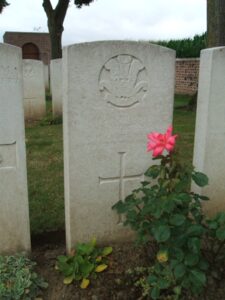
David Morris, Private, 187209, Canadian Infantry. David was born on 31 October 1889, the son of Morris and Mary Morris, of Llanycefn, and had emigrated to Canada before the war. He enlisted at Winnipeg on 11 September 1915 and was posted to the 1st Canadian Mounted Rifles, which were attached to the 8th Canadian Brigade, 3rd Canadian Division. The Division saw its first action at Mount Sorrel in June 1916, and then moved to the Somme, where it remained for the remainder of the year. In 1917 it took part in the Battle of Vimy Ridge, and the resulting Battle of Arras, before moving to Ypres, and fighting at Passchendaele. On 8 August 1918 the Division was one of the units that launched the successful attack against the Germans south of the Somme, and it was that day that David was killed. He was 28 years old, and is buried at Hangard Communal Cemetery Extension, France. His brother William also died due to the effects of the war.
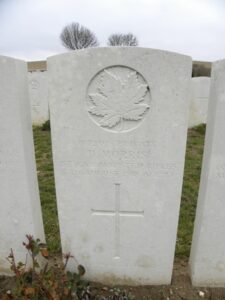
William Morris, Private, 22561, Welsh Regiment. William was born at Llanycefn in 1885, the son of Morris and Mary Morris, of Llanycefn. He enlisted at Blaengarw into the Welsh Regiment. His number shows that he was probably with the 16th Welsh, part of 114 Brigade, 38th (Welsh) Division, which had been in France since December 1915, and had seen action in Flanders before moving to the Somme in June 1916, where it fought at Mametz Wood. It then returned to Flanders, and took part in the Battle of Pilckem Ridge in July 1917, before spending the last winter of the war around Armentieres. In March 1918 the Division was rushed to positions on the Somme to reinforce the thinly stretched lines there, after the German offensive of March 1918, and moved to the Aveluy Sector. William was probably wounded at some time, as he was transferred to the Labour Corps, and died as a result of his war service on 6 October 1918. He is buried at Llanycefn Churchyard. His brother David also fell.
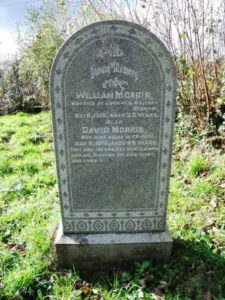
Frederick Lloyd Phillips, Private, 45045, Welsh Regiment. Frederick was the son of Thomas and Margaret Phillips, of Penbrist, Rosebush, Maenclochog. He enlisted at Carmarthen into the 15th (Carmarthen) Battalion, the Welsh Regiment, part of 114 Brigade, 38th (Welsh) Division. The Division fought at Mametz Wood and Passchendaele, and played a major part in the defence of the Somme Sector in 1918 at the time of the German Offensive. After several months in a defensive role, the 15th Welsh led the way across the flooded River Ancre, and began the great offensive which was to win the war. It was during the Second Battle of Bapaume that Frederick was wounded. Frederick Died of Wounds on 5 September, 1918 aged 29. He had been evacuated to the Military Hospital at Rouen, where he now lies in St. Sever Cemetery Extension, France.
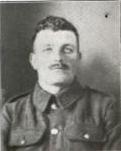
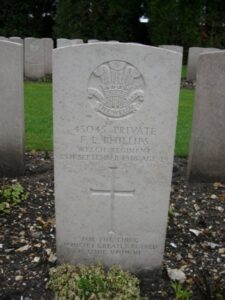
James Salisbury Price, Private, 32061, Welsh Regiment. James was born at Hope, near Leominster in 1897 the son of James and Elizabeth Price. His father was from Spring Field, New Moat, and James spent a lot of time back with his family during the coming years. By the outbreak of war the family was residing at Bristol House, 6, Queen Street, Nantyglo, and James enlisted at nearby Abertillery into the 13th Battalion, South Wales Borderers. James was then transferred to the 16th Battalion (Cardiff City), Welsh Regiment, which was in France attached to 115 Brigade, 38th (Welsh) Division. He probably joined the battalion after it had taken part in the Battle of Mametz Wood in July 1916. The Division had been decimated during its two attacks on the wood, and was transferred to a quieter sector along the Boesinghe Canal at Ypres to rebuild. The 16th Welsh first took up the line here on 19 August 1916, spending the coming weeks alternating between spells in the line and in reserve. James was wounded during these early days at Boesinghe, and was evacuated to Remi Siding Casualty Clearing Station, where he died of his wounds on 15 September 1916, aged 19. James is buried in Lijssenthoek Military Cemetery, Belgium.
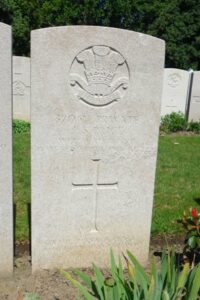
Evan Pritchard, Private, 54620, Welsh Regiment. Evan was the son of Hugh and Martha Pritchard, of Tyllosg, Maenclochog. He enlisted at Cardiff into the Army and was posted to France to join the 9th Battalion, Welsh Regiment, which was attached to 58 Brigade, 19th (Western) Division. The Division had been in France since July 1915, and had fought at Loos, the Somme, Messines and Passchendaele. Over the winter of 1917-1918 the Division was in the line near Arras, and it was there that Evan was killed on 27 February 1918. He was 35 years old, and is buried at Hermies Hill British Cemetery, France.
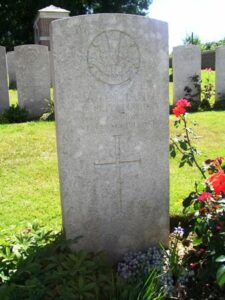
Reginald Roy Quinn, Sergeant, 23286, Royal Engineers. Reginald was the son of John and Emily Quinn, of Islington, London, and the husband of Charlotte Quinn, of Gwalia House, Maenclochog. He enlisted into the Royal Engineers, and served with their 3rd Signal Company. Each infantry Division included a Signals Company with a total strength of 160 men, which was organised into a Company HQ and 4 Sections, of which No 1 Section was responsible for communications with Divisional HQ and Numbers 2-4 with the Brigades of the Division. Reginald was wounded during the stalemate period of 1918, after the German offensive had petered out. He died of his wounds on 6 June 1918, aged 28, and is buried at Pernes British Cemetery, France.

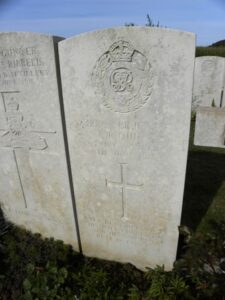
John Brinley Rees, Ordinary Seaman, Z/4541, Royal Naval Volunteer Reserve. John was born in Neath on 6 March 1900, the son of John and Jane Rees. The family later resided at Llysyfran, Clarbeston Road. He enlisted towards the end of the war into the Royal Naval Volunteer Reserve, and was training at the Royal Naval Depot at Crystal Palace when he died on 24 May 1918. John was just 18 years old, and is buried at Maenclochog (St. Mary) Churchyard.
Stanley Rees, Private, 19856, South Wales Borderers. Stanley was the son of George and Phoebe Rees, of Spring Villa, Maenclochog, and enlisted at Tottenham into the 1st Battalion, South Wales Borderers. The Battalion was attached to 3 Brigade, 1st Division, and moved to France at the outbreak of hostilities, and saw its first action at the Battle of Mons, and taking part in the retreat to the Marne, where the Germans were stopped. They then fought at the Aisne, and at Chivy, before being moved north to Ypres. Here they fought at the First Battle of Ypres, where they again stopped the German Offensive, before wintering in Flanders. The following year saw them in action again at the Battle of Aubers, before moving South to Loos, where they fought during the Battle of Loos, and the action at the Hohenzollern redoubt. Again they were required for a major offensive, moving south to the Somme, where they fought during the opening of the Somme Offensive at the Battle of Albert, then at Bazentin, and at Pozières. Stanley was badly wounded at Pozières, and died of his wounds on 22 August 1916. He was 22 years old, and is buried at Flatiron Copse Cemetery, Mametz, France.
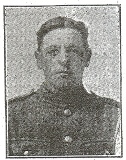
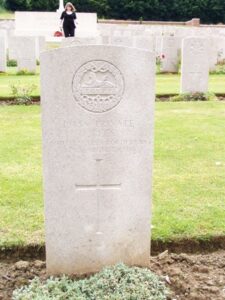
Benjamin Williams, Private, M/296920, Army Service Corps. Benjamin was born at Holmus Fach, Henry’s Moat, the son of Benjamin and Anne Williams. Very little is known of him, but he died of sickness on 21 April, 1917 aged 31, and is buried at Henry’s Moat (Horeb) Baptist Chapelyard.
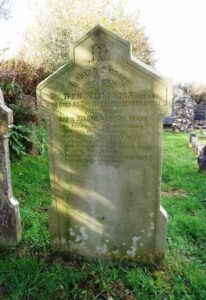
Richard John Williams, Private, 56653, Royal Welsh Fusiliers. Richard was the son of Daniel and Mary Williams, of 71, Bigyn Hill, Llanelly. His parents were from Maenclochog, and after Daniels death, Mary moved the family back to Maenclochog prior to the war. Richard originally enlisted into the Welsh Regiment, being allotted the service number 45585, and after training at Kinmel Park was posted to the 14th Battalion, Royal Welsh Fusiliers, which was in France as part of 113 Brigade, 38th (Welsh) Division. The Division had been on the Western Front since December 1915, and had seen action in Flanders before moving to the Somme in June 1916, where it fought at Mametz Wood. It then returned to Flanders, and took part in the Battle of Pilckem Ridge in July 1917, before spending the last winter of the war around Armentieres. In March 1918 the Division was rushed to positions on the Somme to reinforce the thinly stretched lines there, after the German offensive of March 1918, and moved to the Aveluy Sector. Richard died while at Aveluy, on 18 July 1918. He was 27 years old, and is buried at Tourgeville Military Cemetery, France.
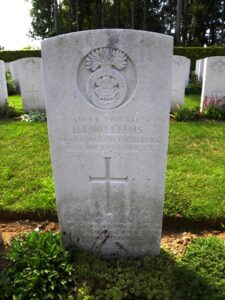
World War Two, 1939-1945
Tom Howell Phillips, Private, 7625457, Royal Army Ordnance Corps. Tom was the son of Edmund Howell Phillips, and of Emily Phillips, of Cotty, Maenclochog. He served with the Royal Army Ordnance Corps, but had been attached to 68 Medium Regiment, Royal Artillery in Eritrea. Tom died during the campaign against the Italian Forces in Eritrea on 6 May 1941, aged 24. He is buried in Asmara War Cemetery, Eritrea. Tom is commemorated at Tufton, and on his parents grave at Henrys Moat.
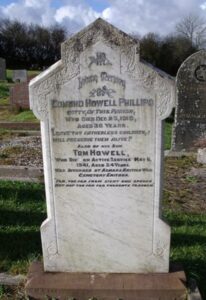
Donald Blair Shute, Gunner, 925730, Royal Artillery. Donald was the son of Tasmania J. Shute and Sarah Theodocia Shute, of Rosebush. He served with 160 (M) H.A.A. Regiment, Royal Artillery, which was an anti-aircraft unit. Donald died on active service at Portsmouth on 1 July 1942, aged 21. He was brought home for burial at Llanycefn Churchyard.
